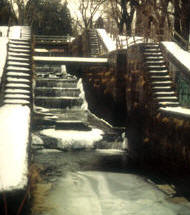The construction of the old Champlain Canal
was begun in 1817. The canal officially opened to boat
traffic in 1822. It provided direct access for freight and
passenger boats from Lake Champlain at Whitehall to Fort
Edward on the Hudson River, completing an inland route from
the St. Lawrence River to the docks of New York City.
The first feeder canal was
dug about 1822 , at the foot of Fort Edward hill, to direct
water from the Hudson River one half mile east to the
Champlain Canal. When a flood destroyed part of the dam
across the Hudson River at Fort Edward, the feeder canal
failed to provide sufficient water.
In 1824, a new dam was built
across the Hudson River upstream from Wings Falls (now Glens
Falls) and the Feeder Canal was begun. It ran seven miles
eastward to join the Champlain Canal, guaranteeing adequate
water at its summit.


In 1832, the Feeder Canal was widened and
deepened to accommodate boat traffic. Thirteen masonry locks
were constructed to overcome the 130-foot vertical drop east
of Sandy Hill (now Hudson Falls).
This engineering feat
includes the popular Five Combines in Kingsbury.
Mills and factories sprouted
up along the Feeder Canal's banks. There were six boat
basins for loading, unloading and repairs. The bounty of the
North Country - lumber, lime, marble, paper, clay, apples
and potatoes - was shipped to New York City and southern
markets from Queensbury, Glens Falls, Hudson Falls, and
Kingsbury. The canal enjoyed prosperity for about 100 years
until newer, more efficient transportation routes were
established. The present-day Champlain Barge Canal replaced
the old canal in the early 1900's.
NEXT